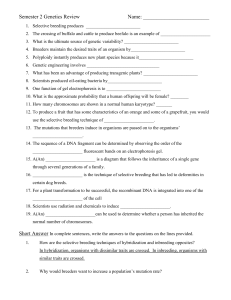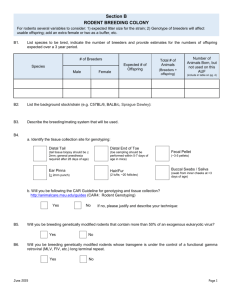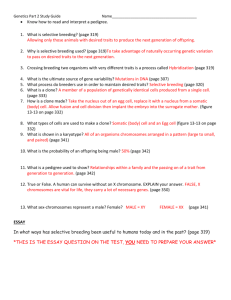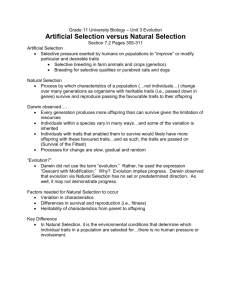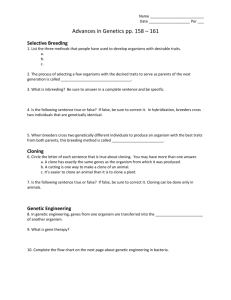Inheriting Your Future - American Federation of New Zealand Rabbit
advertisement
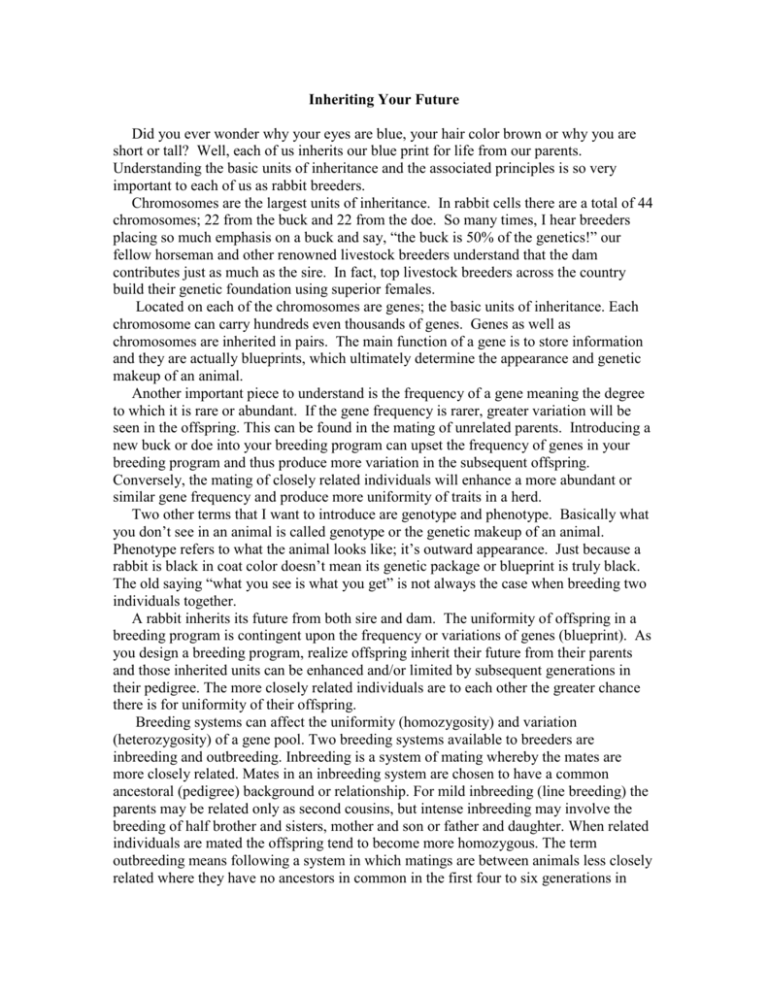
Inheriting Your Future Did you ever wonder why your eyes are blue, your hair color brown or why you are short or tall? Well, each of us inherits our blue print for life from our parents. Understanding the basic units of inheritance and the associated principles is so very important to each of us as rabbit breeders. Chromosomes are the largest units of inheritance. In rabbit cells there are a total of 44 chromosomes; 22 from the buck and 22 from the doe. So many times, I hear breeders placing so much emphasis on a buck and say, “the buck is 50% of the genetics!” our fellow horseman and other renowned livestock breeders understand that the dam contributes just as much as the sire. In fact, top livestock breeders across the country build their genetic foundation using superior females. Located on each of the chromosomes are genes; the basic units of inheritance. Each chromosome can carry hundreds even thousands of genes. Genes as well as chromosomes are inherited in pairs. The main function of a gene is to store information and they are actually blueprints, which ultimately determine the appearance and genetic makeup of an animal. Another important piece to understand is the frequency of a gene meaning the degree to which it is rare or abundant. If the gene frequency is rarer, greater variation will be seen in the offspring. This can be found in the mating of unrelated parents. Introducing a new buck or doe into your breeding program can upset the frequency of genes in your breeding program and thus produce more variation in the subsequent offspring. Conversely, the mating of closely related individuals will enhance a more abundant or similar gene frequency and produce more uniformity of traits in a herd. Two other terms that I want to introduce are genotype and phenotype. Basically what you don’t see in an animal is called genotype or the genetic makeup of an animal. Phenotype refers to what the animal looks like; it’s outward appearance. Just because a rabbit is black in coat color doesn’t mean its genetic package or blueprint is truly black. The old saying “what you see is what you get” is not always the case when breeding two individuals together. A rabbit inherits its future from both sire and dam. The uniformity of offspring in a breeding program is contingent upon the frequency or variations of genes (blueprint). As you design a breeding program, realize offspring inherit their future from their parents and those inherited units can be enhanced and/or limited by subsequent generations in their pedigree. The more closely related individuals are to each other the greater chance there is for uniformity of their offspring. Breeding systems can affect the uniformity (homozygosity) and variation (heterozygosity) of a gene pool. Two breeding systems available to breeders are inbreeding and outbreeding. Inbreeding is a system of mating whereby the mates are more closely related. Mates in an inbreeding system are chosen to have a common ancestoral (pedigree) background or relationship. For mild inbreeding (line breeding) the parents may be related only as second cousins, but intense inbreeding may involve the breeding of half brother and sisters, mother and son or father and daughter. When related individuals are mated the offspring tend to become more homozygous. The term outbreeding means following a system in which matings are between animals less closely related where they have no ancestors in common in the first four to six generations in their pedigrees. Outbreeding is the most common system used by breeders. Outbreeding systems are responsible for making marked changes in type and other characteristics. Simply, outbreeding brings about change in a herd while inbreeding brings about and maintains uniformity in a herd. So how does all this mumbo jumbo work for you as a breeder of New Zealands? Well let’s run through a scenario. You have a problem with weak shoulders in your herd and you would like to fix the problem. A breeder has shown you two bucks, both have excellent type with strong shoulders. But which buck has the best chance of passing his desirable traits on to his offspring? This is where you need to study the pedigree (the genotypic side of the animal) to see how closely related the rabbits are on his pedigree. Is this buck line bred 3 or 4 generations or is this buck the result of an outcross with very few if any animals related in his pedigree. Line bred rabbits have a greater probability of passing on their traits than does a rabbit of non-related ancestors (outcross). So the best buck to buy is the one that can give you the highest probability of acquiring the trait(s) you are looking for and line bred rabbits invariably will have a greater opportunity of producing the kind of rabbits you are seeking in your herd. Remember as you tighten your gene pool, you not only enhance the good traits, but the bad traits as well. There is a point when you as a breeder can get your herd so tight genetically that an infusion of a new gene pool is necessary. The more uniform or homozygous a gene pool becomes, the greater chance for undesirable traits to surface as well as the desirable traits. As the gene pool becomes more homozygous, a greater emphasis must be placed on selecting individuals which express superior genetics for the various traits. My final comments are related to trait heritability. Some traits are highly heritable such as growth, milk, and type and other traits are lowly heritable such as reproduction and health. Highly heritable traits are more easily passed on to the next generation while lowly heritable traits are more difficult to pass on to the next generation. Thus, trait selection is extremely important for the success of future generations. The success of your breeding program hinges on your ability to line up the genetic blue prints in your herd in concert with strict trait selection criteria for growth, reproduction and health. Once you understand how animals inherit their future, you are then on your way to producing genetically superior rabbits. By: David A. Mangione Associate Professor The Ohio State University


